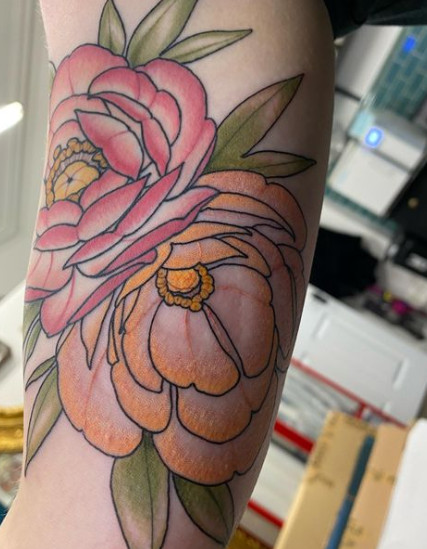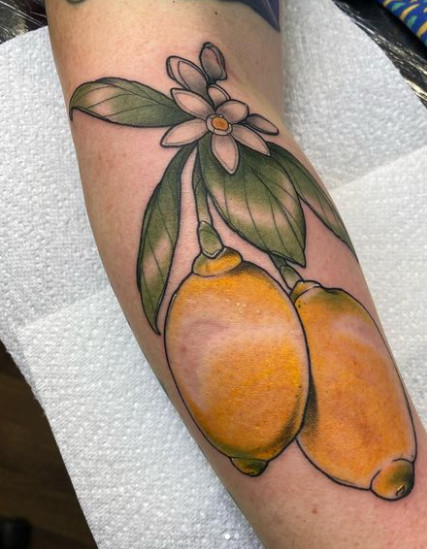Can You Tattoo Over Sunburn? No, tattooing over sunburnt skin is strongly discouraged due to the potential for severe skin damage, increased pain, and a higher risk of infection; it’s best to wait until the sunburn is completely healed before getting inked. At tattooat.com, we understand the importance of protecting your skin and ensuring the best possible tattoo experience, so knowing when your skin is in the right condition for a tattoo is vital.
Sunburn compromises the skin’s integrity, making it a poor canvas for tattooing; prioritizing skin health and waiting for full recovery ensures a vibrant, long-lasting tattoo while minimizing complications, and exploring our curated collection of designs and connecting with top-tier artists can make the process even better. Let’s delve into why tattooing over sunburn is a bad idea, how to care for sunburnt skin, and how to protect your tattoos from sun damage.
1. Understanding Sunburn and Its Effects on the Skin
Sunburn is skin damage caused by overexposure to ultraviolet (UV) rays from the sun or artificial sources like tanning beds. Understanding this damage is key before considering any tattoo work.
1.1 What Is Sunburn?
Sunburn is an inflammatory response to UV radiation, which damages the DNA in skin cells. According to the American Academy of Dermatology, sunburn can occur within 15 minutes of sun exposure, depending on skin type and the intensity of the UV rays.
1.2 How Sunburn Affects the Skin
Sunburn affects the outer layers of the skin, causing redness, pain, and inflammation. Severe sunburn can lead to blistering and peeling. This damage compromises the skin’s ability to heal properly, making it unsuitable for tattooing. Here’s a breakdown:
- Inflammation: Sunburnt skin is already inflamed and sensitive.
- Skin Damage: UV rays damage skin cells, weakening the skin’s structure.
- Compromised Healing: The skin’s natural healing process is disrupted.
- Increased Sensitivity: Even light touch can be painful.
 Red and peeling skin from sunburn indicating why tattooing over sunburn is a bad idea
Red and peeling skin from sunburn indicating why tattooing over sunburn is a bad idea
1.3 Why Damaged Skin Is Not Suitable for Tattooing
Tattooing involves repeatedly puncturing the skin with needles to inject ink. Tattooing sunburnt skin can lead to:
- Increased Pain: Sunburnt skin is highly sensitive, making the tattooing process more painful.
- Poor Ink Absorption: Damaged skin may not hold ink properly, resulting in a patchy or faded tattoo.
- Higher Risk of Infection: Sunburn compromises the skin’s barrier function, increasing the risk of bacterial infections.
- Prolonged Healing Time: Tattooing over sunburn can delay the healing process and increase the likelihood of complications.
2. The Risks of Tattooing Over Sunburn
Tattooing over sunburnt skin can lead to several complications that affect both the tattoo’s appearance and your skin’s health.
2.1 Increased Pain and Discomfort
Sunburnt skin is already inflamed and tender, making the tattooing process significantly more painful. The added trauma can cause extreme discomfort and may require breaks during the session.
2.2 Poor Ink Quality and Tattoo Appearance
Damaged skin does not hold ink well. The tattoo may appear faded, patchy, or uneven. According to tattoo artist Hannah Gehrke, “the lines blister, burst, scab, and then drop out, resulting in a very patchy-looking tattoo.” This can lead to disappointment with the final result and the need for costly touch-ups.
2.3 Increased Risk of Infection
Sunburn weakens the skin’s protective barrier, making it easier for bacteria to enter. Tattooing over sunburnt skin significantly increases the risk of infections, which can lead to serious health complications.
2.4 Prolonged Healing and Scarring
The healing process is already challenging for a new tattoo. Tattooing over sunburnt skin can prolong healing time and increase the risk of scarring. Damaged skin struggles to regenerate properly, leading to unsightly marks and potential keloid formation.
2.5 Potential for Permanent Skin Damage
In severe cases, tattooing over sunburnt skin can cause permanent skin damage. This includes discoloration, uneven texture, and a higher susceptibility to future sun damage.
3. Tattoo Artists’ Perspective on Tattooing Sunburnt Skin
Most professional tattoo artists will refuse to tattoo sunburnt skin due to the risks involved. Their primary concern is the client’s safety and the quality of their work.
3.1 Why Most Artists Refuse to Tattoo Sunburnt Skin
Artists prioritize the health and safety of their clients. Tattooing over sunburnt skin goes against this principle. Hannah Gehrke firmly advises, “No, don’t do it! Sunburn is, first and foremost, skin damage from overexposure to the sun (UV rays) and affects the outer layers of your skin.”
3.2 The Importance of Being Honest with Your Artist
If you have sunburn, it is crucial to inform your tattoo artist before your appointment. Honesty allows them to assess the skin’s condition and make an informed decision. They may suggest rescheduling the appointment or altering the tattoo placement to avoid the affected area.
3.3 What to Expect If You Show Up with Sunburnt Skin
If you arrive at your appointment with sunburnt skin, your tattoo artist will likely refuse to proceed. They may offer to reschedule once your skin has fully healed. Some artists may charge a cancellation fee, so it’s essential to communicate with them in advance.
4. How Long to Wait After Sunburn Before Getting a Tattoo
Patience is key when it comes to tattooing after sunburn. Allowing your skin to fully heal is essential for the best results and to minimize risks.
4.1 Assessing the Severity of the Sunburn
The waiting period depends on the severity of the sunburn. Mild sunburn, characterized by redness and minor discomfort, may require a shorter waiting time compared to severe sunburn with blistering and peeling.
4.2 General Guidelines for Waiting Time
As a general guideline, wait until all signs of sunburn have completely disappeared before considering a tattoo. This typically takes:
- Mild Sunburn: 1-2 weeks
- Moderate Sunburn: 2-4 weeks
- Severe Sunburn: 4-8 weeks or longer
4.3 Signs That Your Skin Has Healed
Before booking a tattoo appointment, ensure your skin exhibits the following signs of healing:
- No Redness: The skin should return to its normal color.
- No Pain or Sensitivity: The area should not be tender to the touch.
- No Peeling or Blistering: All peeling and blistering should have completely resolved.
- Normal Texture: The skin should feel smooth and have its usual texture.
4.4 Expert Advice on Healing Time
According to dermatologists, allowing the skin to fully regenerate is crucial. Dr. Emily Miller, a dermatologist at Portland Clinic, states, “It’s essential to give your skin enough time to heal completely. Tattooing prematurely can lead to complications and affect the tattoo’s appearance.”
5. Caring for Sunburnt Skin to Promote Healing
Proper care of sunburnt skin is essential to accelerate healing and prevent complications.
5.1 Immediate Steps to Take After Sunburn
- Cool the Skin: Take a cool shower or bath to reduce inflammation.
- Apply a Cold Compress: Use a cold compress on the affected areas for 10-15 minutes several times a day.
- Stay Hydrated: Drink plenty of water to rehydrate the skin from the inside out.
5.2 Recommended Products for Sunburn Relief
- Aloe Vera Gel: Apply pure aloe vera gel to soothe and moisturize the skin. Look for products with minimal additives.
- Moisturizers: Use a gentle, fragrance-free moisturizer to keep the skin hydrated.
- Over-the-Counter Pain Relievers: Take ibuprofen or acetaminophen to reduce pain and inflammation.
5.3 What to Avoid When Treating Sunburn
- Harsh Soaps: Avoid using harsh, scented soaps that can further irritate the skin.
- Scratching: Refrain from scratching or picking at peeling skin, as this can lead to infection.
- Tight Clothing: Wear loose, breathable clothing to avoid rubbing against the sunburnt area.
5.4 Natural Remedies for Sunburn
- Oatmeal Bath: Add colloidal oatmeal to a lukewarm bath to relieve itching and inflammation.
- Apple Cider Vinegar: Dilute apple cider vinegar with water and apply to the skin with a cotton ball to reduce inflammation.
- Green Tea Compress: Brew green tea, let it cool, and apply it to the skin with a compress to soothe irritation.
6. Protecting Your Tattoos from Sun Damage
Sun protection is crucial for maintaining the vibrancy and longevity of your tattoos.
6.1 The Importance of Sunscreen for Tattoos
Sun exposure causes tattoos to fade and lose their definition. Sunscreen acts as a barrier, protecting the ink from harmful UV rays.
6.2 Choosing the Right Sunscreen
- SPF: Use a broad-spectrum sunscreen with an SPF of 30 or higher.
- Ingredients: Look for sunscreens containing zinc oxide or titanium dioxide, which provide physical protection.
- Formulation: Choose a lotion or stick formulation for easy application and even coverage.
6.3 How to Apply Sunscreen to Tattoos
- Apply Liberally: Apply sunscreen generously to all exposed areas of the tattoo.
- Reapply Frequently: Reapply every two hours, especially after swimming or sweating.
- Don’t Forget Edges: Pay close attention to the edges of the tattoo, as these areas are prone to burning.
6.4 Other Methods of Sun Protection
- Clothing: Wear loose-fitting clothing that covers your tattoos.
- Shade: Seek shade during peak sun hours (10 AM to 4 PM).
- Hats: Wear a wide-brimmed hat to protect tattoos on your neck and shoulders.
6.5 The Impact of Sun Exposure on Tattoo Ink
Sun exposure breaks down the pigment in tattoo ink, causing it to fade over time. Darker inks, such as black and blue, are more resistant to fading, while lighter colors, such as yellow and white, are more susceptible. Regular sun protection helps preserve the ink’s integrity and keeps your tattoo looking vibrant.
 A person applying sunscreen to their tattooed arm, highlighting the importance of sun protection
A person applying sunscreen to their tattooed arm, highlighting the importance of sun protection
7. What to Do If Your New Tattoo Gets Sunburned
Even with precautions, sunburn can happen. Here’s how to handle it if your new tattoo gets sunburned.
7.1 Recognizing Sunburn on a New Tattoo
Signs of sunburn on a new tattoo include:
- Excessive Redness: More intense than usual redness.
- Swelling: Increased swelling around the tattoo.
- Pain: Heightened pain and sensitivity.
- Blisters: Formation of small, fluid-filled blisters.
7.2 Immediate Steps to Take
- Cool Compress: Apply a cool, damp cloth to the area for 10-15 minutes several times a day.
- Avoid Irritants: Do not apply any creams, lotions, or ointments other than those recommended by your tattoo artist.
- Stay Hydrated: Drink plenty of water to help your skin heal.
7.3 When to Seek Professional Medical Advice
Consult a doctor if you experience:
- Signs of Infection: Increased redness, swelling, pus, or fever.
- Severe Blistering: Large, painful blisters that may require medical attention.
- Extreme Pain: Unbearable pain that doesn’t subside with over-the-counter pain relievers.
7.4 Long-Term Care for a Sunburned Tattoo
After the initial sunburn has subsided, continue to protect the tattoo from further sun exposure. Once the tattoo is fully healed, use sunscreen regularly to prevent fading and damage.
8. Summer Tattoo Tips for Optimal Healing and Appearance
Getting a tattoo in the summer requires extra care to ensure proper healing and maintain its appearance.
8.1 Timing Your Tattoo Appointment
If possible, schedule your tattoo appointment for a time when you can avoid prolonged sun exposure. Consider getting tattooed in the late fall or winter months when the sun is less intense.
8.2 Choosing the Right Clothing
Wear loose, breathable clothing to protect your new tattoo from the sun. Opt for natural fabrics like cotton and linen.
8.3 Staying Hydrated
Drink plenty of water to keep your skin hydrated and promote healing. Avoid excessive alcohol consumption, which can dehydrate the skin.
8.4 Avoiding Swimming and Excessive Sweating
Avoid swimming in pools, oceans, and hot tubs until your tattoo is fully healed. These environments can harbor bacteria that increase the risk of infection. Excessive sweating can also irritate the tattoo, so try to stay cool and dry.
8.5 Aftercare Routine Adjustments for Summer
In the summer, adjust your aftercare routine to accommodate the warmer weather. Clean your tattoo more frequently with a mild, fragrance-free soap to remove sweat and grime. Apply a light, non-greasy moisturizer to keep the skin hydrated without clogging pores.
9. Debunking Common Myths About Tattoos and Sunburn
Several misconceptions exist regarding tattoos and sunburn. Let’s set the record straight.
9.1 Myth: Tattoos Protect Against Sunburn
Fact: Tattoos do not protect against sunburn. Tattooed skin is just as susceptible to sun damage as non-tattooed skin. Always use sunscreen, regardless of whether you have tattoos.
9.2 Myth: You Can Only Get Sunburn on Untattooed Skin
Fact: Sunburn can occur on any exposed skin, including tattooed areas. The ink does not provide any sun protection.
9.3 Myth: Sunburn Doesn’t Affect Old Tattoos
Fact: Sunburn can fade both new and old tattoos. Protecting all your tattoos from sun exposure is essential.
9.4 Myth: Applying Aftercare Products Prevents Sunburn
Fact: While aftercare products help with healing, they do not provide sun protection. You still need to use sunscreen.
9.5 Myth: Tanning Beds Are Safer Than Natural Sunlight for Tattoos
Fact: Tanning beds emit UV radiation that is just as harmful as natural sunlight. Both can damage tattoos and increase the risk of skin cancer.
10. Finding Inspiration and Artists at tattooat.com
At tattooat.com, we are dedicated to providing a platform where tattoo enthusiasts can find inspiration, connect with talented artists, and access valuable information about tattoo care.
10.1 Exploring Tattoo Designs and Styles
Discover a wide range of tattoo designs and styles to find the perfect inspiration for your next piece. Our extensive gallery features everything from traditional to contemporary styles.
10.2 Connecting with Talented Tattoo Artists
Find skilled tattoo artists in your area. Our directory includes artist portfolios, contact information, and client reviews.
10.3 Accessing Expert Advice and Resources
Read articles and guides on tattoo aftercare, sun protection, and other essential topics. Our expert advice helps you make informed decisions about your tattoos.
10.4 Community and Support
Join our community of tattoo enthusiasts to share your experiences, ask questions, and connect with others. Our forum provides a supportive environment for discussing all things tattoo-related.
10.5 Showcasing Your Tattoo
Share your tattoo on tattooat.com, so you can inspire others to find their next tattoo artist. Whether it is black and grey, color, traditional, or realism, we encourage you to find the community, or artist that can help you express yourself.
Can you tattoo over sunburn? Absolutely not! Prioritizing the health of your skin is key to ensuring a vibrant and long-lasting tattoo. By avoiding tattooing over sunburn, caring for sun-damaged skin, and protecting your tattoos from sun exposure, you can enjoy beautiful ink for years to come; discover a world of designs, connect with talented artists, and learn essential tattoo knowledge by visiting tattooat.com today. Let us help you embark on a colorful tattoo journey while keeping your skin healthy and radiant.
FAQ: Tattooing and Sunburn
1. Can I get a tattoo if I have a mild sunburn?
No, even mild sunburn can compromise the skin’s integrity and affect the tattoo’s healing process. It’s best to wait until the sunburn has completely healed.
2. How long should I wait after a sunburn to get a tattoo?
The waiting time depends on the severity of the sunburn. Generally, wait 1-2 weeks for mild sunburn, 2-4 weeks for moderate sunburn, and 4-8 weeks or longer for severe sunburn.
3. What happens if I tattoo over sunburnt skin?
Tattooing over sunburnt skin can lead to increased pain, poor ink absorption, higher risk of infection, prolonged healing time, and potential permanent skin damage.
4. Will a tattoo artist tattoo me if I have sunburn?
Most professional tattoo artists will refuse to tattoo sunburnt skin due to the risks involved.
5. How does sunburn affect the appearance of a tattoo?
Sunburn causes tattoos to fade, blister, and peel, resulting in a patchy or uneven appearance.
6. Can sunscreen prevent sunburn on my tattoo?
Yes, applying a broad-spectrum sunscreen with an SPF of 30 or higher can protect your tattoo from sun damage.
7. What should I do if my new tattoo gets sunburned?
Apply a cool compress, avoid irritants, stay hydrated, and consult a doctor if you experience signs of infection or severe blistering.
8. Is it safe to use tanning beds after getting a tattoo?
No, tanning beds emit UV radiation that can damage tattoos and increase the risk of skin cancer. It’s best to avoid them altogether.
9. Does tattoo ink protect my skin from the sun?
No, tattoo ink does not provide any sun protection. You still need to use sunscreen on tattooed skin.
10. Where can I find reliable information and inspiration for tattoos?
Visit tattooat.com to explore tattoo designs, connect with talented artists, and access expert advice on tattoo care and sun protection.
